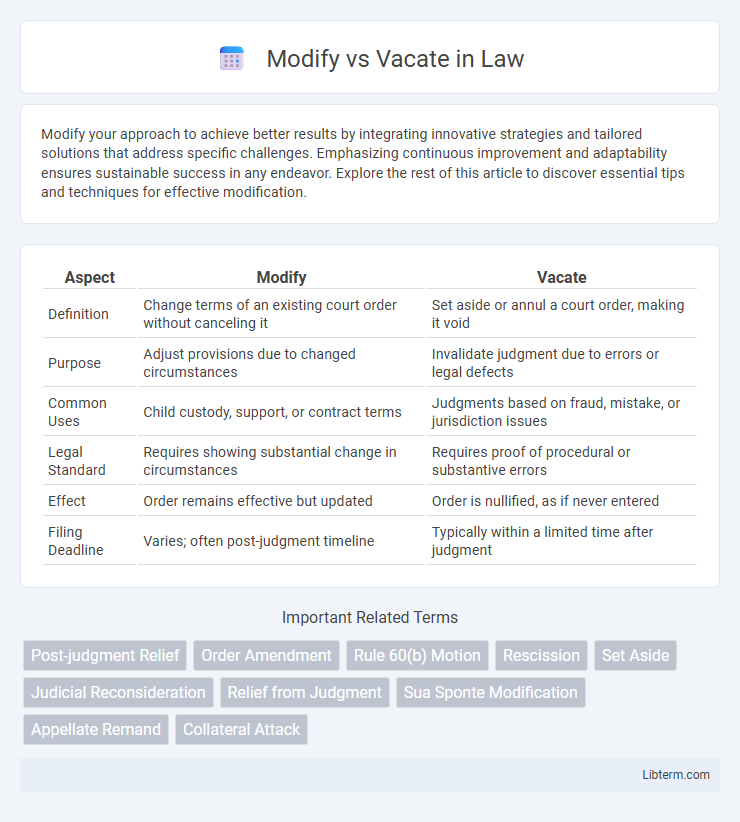Modify your approach to achieve better results by integrating innovative strategies and tailored solutions that address specific challenges. Emphasizing continuous improvement and adaptability ensures sustainable success in any endeavor. Explore the rest of this article to discover essential tips and techniques for effective modification.
Table of Comparison
| Aspect | Modify | Vacate |
|---|---|---|
| Definition | Change terms of an existing court order without canceling it | Set aside or annul a court order, making it void |
| Purpose | Adjust provisions due to changed circumstances | Invalidate judgment due to errors or legal defects |
| Common Uses | Child custody, support, or contract terms | Judgments based on fraud, mistake, or jurisdiction issues |
| Legal Standard | Requires showing substantial change in circumstances | Requires proof of procedural or substantive errors |
| Effect | Order remains effective but updated | Order is nullified, as if never entered |
| Filing Deadline | Varies; often post-judgment timeline | Typically within a limited time after judgment |
Understanding Modify vs Vacate
Understanding Modify vs Vacate involves distinguishing between altering the terms of a court order and completely setting it aside. Modifying a court order means changing specific provisions while the order remains in effect, such as adjusting custody arrangements or payment amounts. Vacating a court order involves nullifying it entirely, as if the order never existed, often due to procedural errors or new evidence.
Key Legal Definitions
Modify refers to the legal act of altering or amending an existing court order or judgment, typically to reflect changes in circumstances or to correct errors. Vacate means to nullify or set aside a prior court decision, effectively erasing its legal effect as if it never existed. Understanding these key legal definitions is essential for litigants seeking to change or challenge court orders in civil, family, or administrative law contexts.
Common Scenarios Requiring Modification
Common scenarios requiring modification include changes in child custody arrangements due to shifts in parental work schedules or relocation, adjustments to child support payments following income fluctuations, and alterations in visitation rights when the child's needs evolve. Courts may grant modification requests when there is a substantial change in circumstances impacting the original order's effectiveness or fairness. These modifications ensure that legal agreements remain relevant and serve the best interests of the involved parties.
Situations Necessitating Vacating Orders
Vacating orders is essential when the original court judgment is rendered void due to procedural errors, fraud, or new evidence that significantly alters the case outcome. Situations necessitating vacating orders include lack of jurisdiction, improper service of process, or discovery of perjured testimony that undermines the judgement's validity. Courts vacate orders to ensure justice by correcting fundamental flaws that make enforcement unjust or legally unsustainable.
Legal Grounds for Modification
Legal grounds for modification require a substantial change in circumstances since the original order, such as changes in income, employment status, or the needs of the child or parties involved. Courts typically consider evidence that the modification serves the best interests of the child or fairness to the parties, including factors like relocation, health issues, or financial hardship. In contrast, vacating an order usually involves demonstrating that the original order was procured through fraud, mistake, lack of jurisdiction, or due to procedural errors.
Legal Grounds for Vacating
Legal grounds for vacating a court order typically include procedural errors, lack of jurisdiction, newly discovered evidence, or fraud upon the court. Vacating an order nullifies its effect based on these substantive deficiencies, whereas modifying an order adjusts its terms without invalidating the original judgment. Courts grant vacatur to ensure fairness and correct injustices that arose during the initial proceedings.
Court Procedures: Modify vs Vacate
Court procedures for modifying a court order typically require filing a petition demonstrating a substantial change in circumstances since the original order was issued, followed by a hearing where both parties present evidence. Vacating an order involves filing a motion to nullify or set aside the judgment, often due to errors, fraud, or lack of jurisdiction, and requires the court to find valid grounds before rescinding the order. Both processes demand strict adherence to procedural rules, including deadlines, notice to involved parties, and sometimes mandatory mediation before judicial consideration.
Impact on Parties Involved
Modifying a court order often allows parties to adjust terms based on changed circumstances, providing flexibility while maintaining legal continuity. Vacating an order effectively nullifies the prior judgment, potentially resetting the legal relationship and requiring parties to resolve issues anew. The impact on parties differs as modification typically preserves existing rights with alterations, whereas vacating can introduce uncertainty and the need for further litigation.
Pros and Cons: Modification vs Vacating
Modification of a legal judgment allows parties to adjust terms based on changed circumstances, providing flexibility and preserving the original decision's intent; however, it may lead to prolonged litigation and uncertainty. Vacating a judgment nullifies it entirely, offering a fresh start and correcting fundamental errors, but can cause delays and undermine finality in legal proceedings. Choosing between modification and vacating depends on factors like the nature of the error, impact on fairness, and the desire to maintain judicial efficiency.
Tips for Filing Modify or Vacate Motions
Filing a motion to modify or vacate requires precise legal language and a clear demonstration of changed circumstances or errors in the original judgment. Gather and submit all relevant documents, such as new evidence, financial records, or court transcripts to strengthen your argument. Consult local court rules to ensure timely filing and proper formatting, increasing the likelihood of a successful motion outcome.
Modify Infographic

 libterm.com
libterm.com